Old Father Thames: Walking from Source to City... Chapter Three
Trip One: Day Three - Lechlade to Newbridge
(Catch up on Chapter Two: Cricklade to Lechlade)
Thou too, aerial pile, whose pinnacles
Point from one shrine like pyramids of fire,
Obey’st I in silence their sweet solemn spells,
Clothing in hues of heaven thy dim and distant spire,
Around whose lessening and invisible height
Gather among the stars the clouds of night.
- PERCY BYSSHE SHELLEY, ‘A SUMMER EVENING CHURCHYARD, LECHLADE, GLOUCESTERSHIRE’
The Shelleys, both Percy and Mary, stayed in the New Inn Hotel at Lechlade on a trip upriver in the summer of 1815, and it was sitting in the churchyard next door that he composed one of his most picturesque poems. Falling asleep to the sound of the bell ringers practising their changes from the slender spired tower, I wondered whether the poet had heard the very same sound on his visit two centuries ago. However, the next morning Lechalde showed a much more modern face.
There is no quaint village cafe for a hearty full English in Lechlade, instead, one is faced with the prospect of two ‘fashionable’ coffee shops. Opting for Lynwood & Co., a very stylish and stripped-back bakery and cafe, part of a small chain around the Cotswolds villages, we found it to be very popular. We had, in fact, seen very few people out and about in Lechlade the evening before but on that bright morning we struggled to get a seat in the buzzing cafe. No sausage and egg here, but rather a very good coffee and something called a ‘cruffin’ which was a delicious cross between a chocolate custard-filled doughnut and a large muffin. A world away from the grocers’ cafe in Cricklade the day before, it was becoming markedly obvious that we had already left behind the truly ‘rural’ Thames, the currents of gentrification have washed upstream as far as Lechlade.
After breakfast we popped into the well-appointed Londis and bought a large pork pie to share for lunch later, knowing in advance the dearth of villages on that day's route. St Lawrence’s Church, with its wonderfully delicate spire, is a symbol for the village, sitting right in the heart of the community alongside the marketplace, town hall, and our hotel… it was, of course, locked. Despite its important role as navigational head of the Thames and eastern gateway to the Cotswolds, Lechalde seems to try its level best to offer a cold shoulder to the visitor. The few shops are all chains, the pubs (with the notable exception of The Trout) are all run by ‘managers’ and feel like the lobby of a city hotel, cars fill the marketplace and the church is locked.
Taking our bags from the hotel we begin the day’s walk. The stretch of river between here and Oxford is known as ‘the Lonely Thames’ since it passes through so few places. For the next 30 miles the river is left to its own devices, meandering through flood meadows between rushes, willows and the occasional lock. In 1907 Hilaire Belloc suggested that someone transplanted from the Fifteenth Century could travel for miles downstream from Lechlade without knowing they had left their own age. Little has changed since Belloc’s time other than the occasional heavy-duty power line and the series of concrete pillboxes scattered along the bank every half mile or so. These relics of the Second World War were once the final line of defence against the prospect of a Nazi invasion of southern England and utilised the same natural barrier that in Saxon times protected Wessex from the Norsemen of Mercia.
The sun shines, the path is clear and the walking is easy.
At St John’s lock, the first (or last, depending on our direction of travel) on the Thames, there is a lifesize concrete figure of Old Father Thames himself. This particular effigy was cast for the Great Exhibition of 1854 where he flanked the entrance to Paxton’s great crystal palace. Then, from 1958 to 1974 he was placed in the field at Trewsbury Mead where the source of the river is today marked by a simple stone. Finally, to protect the ageing river god from vandalism, he was deposited under the watchful eye of the lock keeper at Lechlade where we found him that bright morning.
After skirting the edge of Buscot Park, a large estate now owned by the National Trust, the great chimneys of the house just visible above the tree line, we reach Kelmscott Manor, the country home of William Morris, his wife Jane, and any other member of the Arts & Crafts and Pre-Raphaelite gang who cared to come and stay. It was here that the majority of the long-running affair between Jane Morris and Dante Gabriel Rossetti was carried out. Its outbuildings are only just visible from the path but the main house itself is an attractive many-gabled manor in the Jacobean style and is furnished with a vast array of Morris & Co. designs for wallpaper, fabrics, and furniture. It is open to the public throughout the summer months.
Morris described Kelmscott and its surrounding country as ‘heaven on earth’ but this is only the first of three houses that he owned along the length of the Thames. We will encounter the designer and campaigner again at his city home in Hammersmith and beyond the Woolwich barrier is the famous Red House, designed by Philip Webb, just a few miles from the river at Bexleyheath.
Our tight schedule does not allow us time to linger in Morris’ heaven, we must reach Newbridge, virtually the old ‘place’ on the river between Lechlade and Oxford, before the final bus departs for Abingdon at 5:15 pm. That means we have just over 17 miles to cover on this final day of the trip, our longest day yet. Newbridge is not in fact a ‘place’ per say but simply two pubs one on each foot of an ancient bridge…and a bus stop.
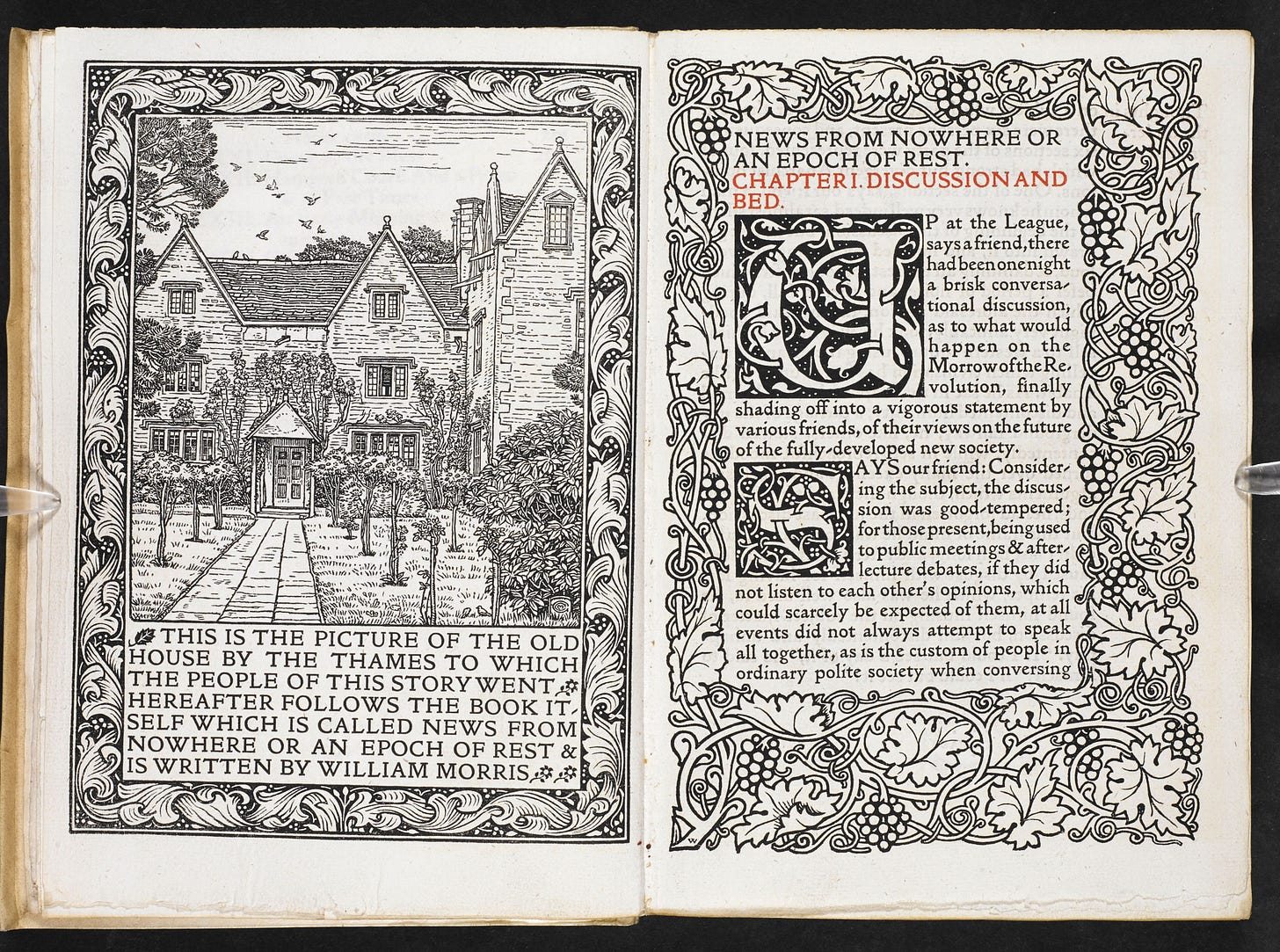
Our next check-point, after more fields, meadows and pillboxes, is Racot Bridge. As seemingly with every stop along the river, the strata of history run deep at Radcot. There is evidence of a 12th-century Norman castle on the banks, which may have played host to Empress Matilda during her long civil war over the crown of England with King Stephen. The river crossing itself was the site of two further civil war encounters, firstly, in 1387, the clash that saw forces loyal to the ill-fated Richard II, led by the Earl of Oxford who was allegedly the young King’s lover, routed by the superior force of Henry Bolingbroke - the future Henry IV. And then again in 1645 when royalist forces secured the bridge, the crucial route to King Charles’ court at Oxford, after a skirmish with parliament's army. All this information is displayed proudly on the walls of The Swan pub, where we sit at the bar with a half pint, listening to the crackling fire and flicking through a copy of Towpath Talk found on the windowsill.
Onwards, through similar landscape, towards our next target, the charmingly named Tadpole Bridge. At one of the locks, we get talking to a tall and bald-headed lock keeper who, after we tell him we’re aiming for Newbridge, informs us we’re right on schedule.
“Yes, the Newbridge walkers normally come by this time of morning,” he says, looking at his watch. The conversation moves on to the high water level and the previous day’s flooding.
“See the lock there…” he says, pointing to the brimmed murky channel, “...that's ‘empty’...”
It takes a moment for this direct contradiction of the apparent evidence to sink in. What he meant was that the lock was set to empty out, the lower gates open and the top ones closed, however, on closer inspection the level of the river before, inside, and after the lock was identical and very fast moving.
“You’d have to be pretty foolish to take a boat out today,” he says, with a smile on his face.
As if to reinforce this point, round the next bend the current whips quickly past the upturned hull of the pleasure boat in the middle of the river, there is a huge jagged gash in the side of the vessel that makes it look like a prop from Jaws.
At Tadpole Bridge we cross the eponymous structure to the very slick-looking pub, yet another Trout. We look distinctly out of place in our fleeces, muddy boots and hiking rucksacks as we walk past the owners of the Range Rovers on the gravel outside eating their Saturday lunches. With another couple of halves and a knife from the cutlery table, we make our way out to the Thames-side garden to enjoy the pie we bought in Lechlade. Progress has been good, with only seven miles left to Newbridge and more than three hours until our bus. Little did we know as we drank cider and ate an excellent pork pie, how difficult those miles would be.
Not more than a quarter of a mile after our lunch stop we found a couple of walkers looking lost. As we got closer it became apparent that the path ahead, trapped between a wooded bank and the river, was flooded. Chatting to the walkers, who were contemplating whether to get their feet wet, we explained our trails with flooding yesterday and offered to lead the way. They reluctantly followed as we ploughed our way through the less flooded fringes of the path where vegetation was visible through the water, but before very long it was over our boots and then swiftly up to our shins. After a short while, as the water began to deepen, it became increasingly clear that going back was no longer an option. We were now already quite wet and any alternative route along the roads would involve miles of detour and meant we’d certainly miss our bus, so we pushed on, up to our thighs in the flood water.
After about a mile of floods, we reached the edge of a large nature reserve where the Thames is separated from very low-lying water meadows by a high bank. As such the path here was quite dry other than one moment where the force of the river had broken through the bank and created a deep, fast-moving trench through which the water poured into the meadows on the other side. It was too big to leap so we waded through its surging current. Our wet boots becoming increasingly heavy and uncomfortable, we took refuge in a bird hide, raised high on stilts at the far end of the reserve and got to work wringing out our socks. The walkers we had led earlier overtook us and headed on towards Shifford Lock.
Partially refreshed, with a little less water sloshing in our boots, we too continued to the lock. By this time, it had become apparent the additional weight of my wet boots had taken a toll on my ankle, my right Achilles tendon was now quite sore with every step. But, glad that those floods were behind us, and now only a handful of miles from Newbridge, we got to Shifford Lock in good spirits. Then we saw the bridge. A typical arched wooden footbridge, but where this one differed from the others we’d seen and crossed that day was that rather than spanning the river, both ends of this particular bridge sat semi-submerged in the water.
There was no choice, we had floods behind us and floods ahead of us. We were already so soaked and pushed for time that we just had to carry on. The field beyond was no better, the banks of the river no longer visible as water spread across the surrounding landscape. The Thames and the fields had become indistinguishable. We waded on, up to our waists, making slow progress through field after field. The cold and slogging monotony was only broken when suddenly a skylark shot from the waterlogged grass someway distant and climbed, crying, into the sky. Quite an extraordinary moment that is very clear in my memory, never having seen a skylark up close before, its piercing rhythmic song ascended over the flooded fields and disappeared into the air.
In the next field, the flooding reached its worst. We had tried picking our way where the grass was just visible under the surface, the bank of the river was slightly higher than the surrounding meadow so it could just about be followed, but we came to a point where the ground dropped away under the surface at all sides. We had to pick a path past a large bush, somewhere on one side was the Thames and on the other the path, but there was no sign which was which.
I tried the right side first and tentatively walked forward until the water reached my navel. Abandoning that, I suggested Dad try the left side. After two steps he suddenly began to slide slowly but quite deeply into the water, he reached out and I tried to pull him back, causing myself to slide deeper into the water and the invisible mud below. We had found the edge of the Thames.
After thrashing about to recover ourselves, we heard a shout and saw the walkers from earlier, some way ahead, and signalling with a large stick a path through the flood which they had taken themselves. We caught up with them and shared the final mile of flooding together, avoiding the last of the water by gingerly picking our way through a thickly wooded bank. In that woodland, we found two ladies with a small cheerful dog. Never have I seen four walkers so emphatically warn others off taking a path. They were just going to casually stroll to Shifford Lock before the sunset, the volume of Thames water absorbed into our clothing told them this was not a feasible plan and they too joined our sodden band heading back the way they’d come towards Newbridge. The two ladies were also walking the length of the Thames (upstream from London) but, they admitted, in stages…over the last seventeen years.
“We’ve had several jobs, homes, and children since we started out…this isn’t the same dog we started with.”
We were so soaked and cold, since the sun was nearly set, when we reached Newbridge and The Rose Revived pub, another manager-run gastro-destination, that the prospect of travelling back to Cardiff on two buses and a train made us consider taking a room at the pub on the spur of the moment. An overweight and over-promoted manager in an unironed and untucked shirt looked us over, exhausted, muddy, dripping water on the flagstones of his pub, and took a very long time to make up a price which he was prepared to charge us for a room.
“...£150”, he said, haughtily.
“For a twin room?”, I asked.
He looked at me like I’d asked for a gold-plated four-poster bed.
“No.”
Dad very nearly shook his hand there and then but, despite shivering with cold, I was still aware enough to know we were being had. We told the manager we’d think about it and, over a coffee, I checked the bus times. The last bus of the day was in ten minutes.
Three hours later we were back in Cardiff. Exhausted, cold, and very soggy, but mighty pleased with ourselves after covering forty miles in three days, and ready to plan the next trip for the following month!
Trip Two, via Oxford, Abingdon, Dorchester and Wallingford, coming soon…
(Thank you for reading! If you enjoyed, please consider subscribing to get all future instalments sent straight to your email inbox. You can also choose to support my writing (and walking) by choosing a paid subscription option.)


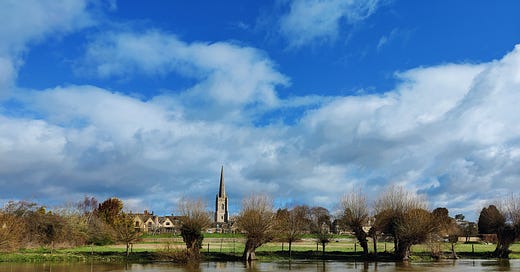




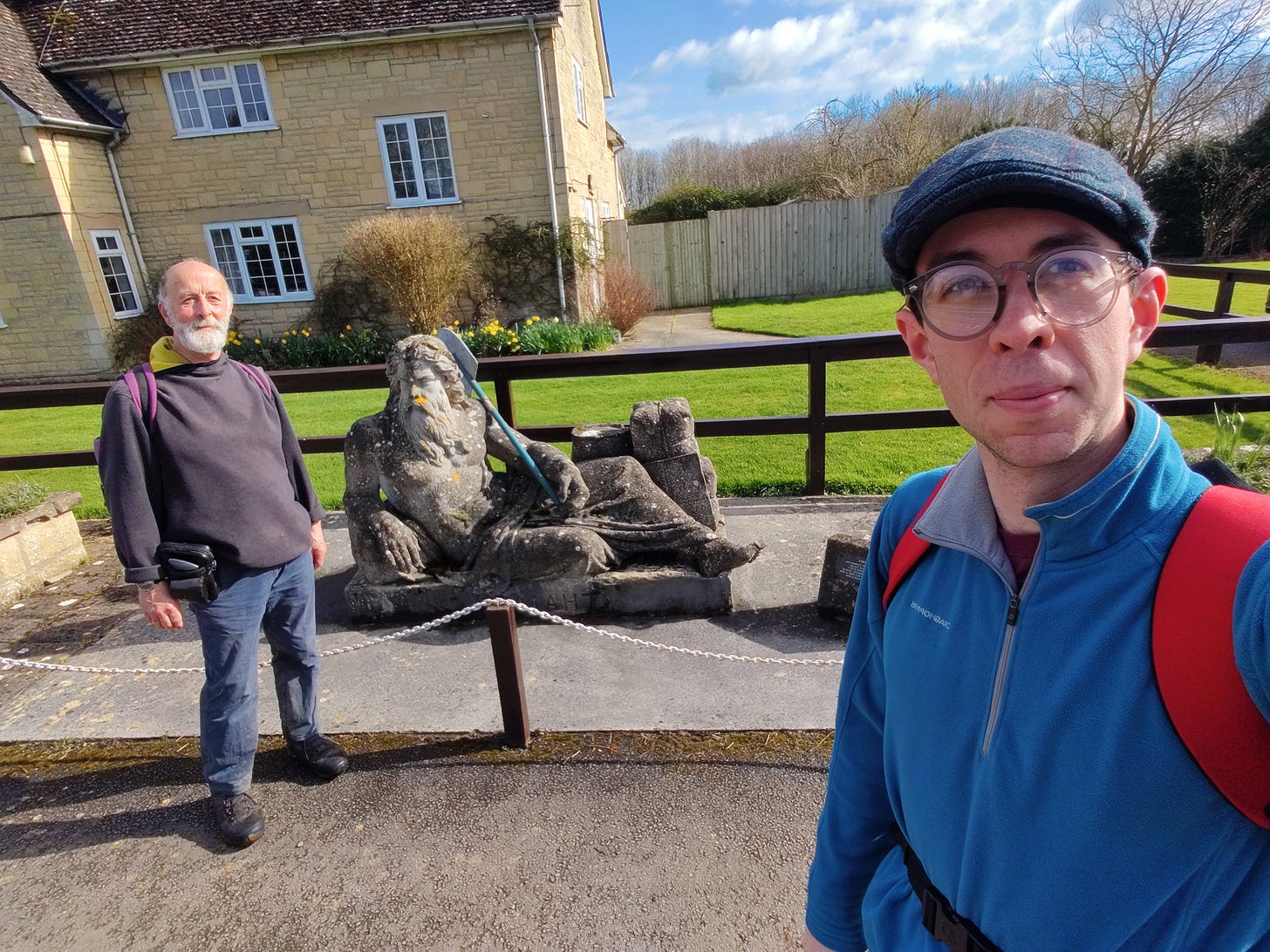

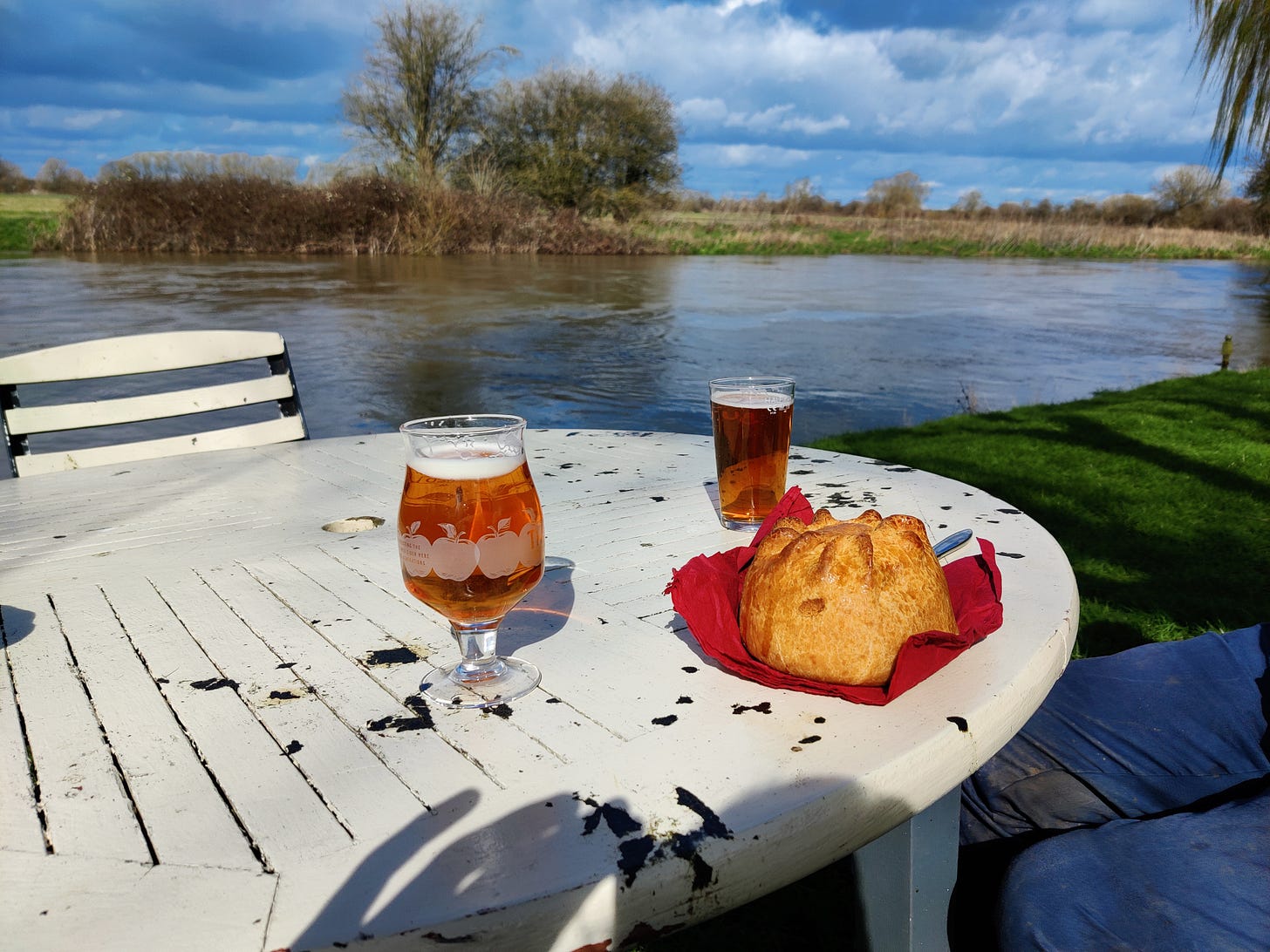
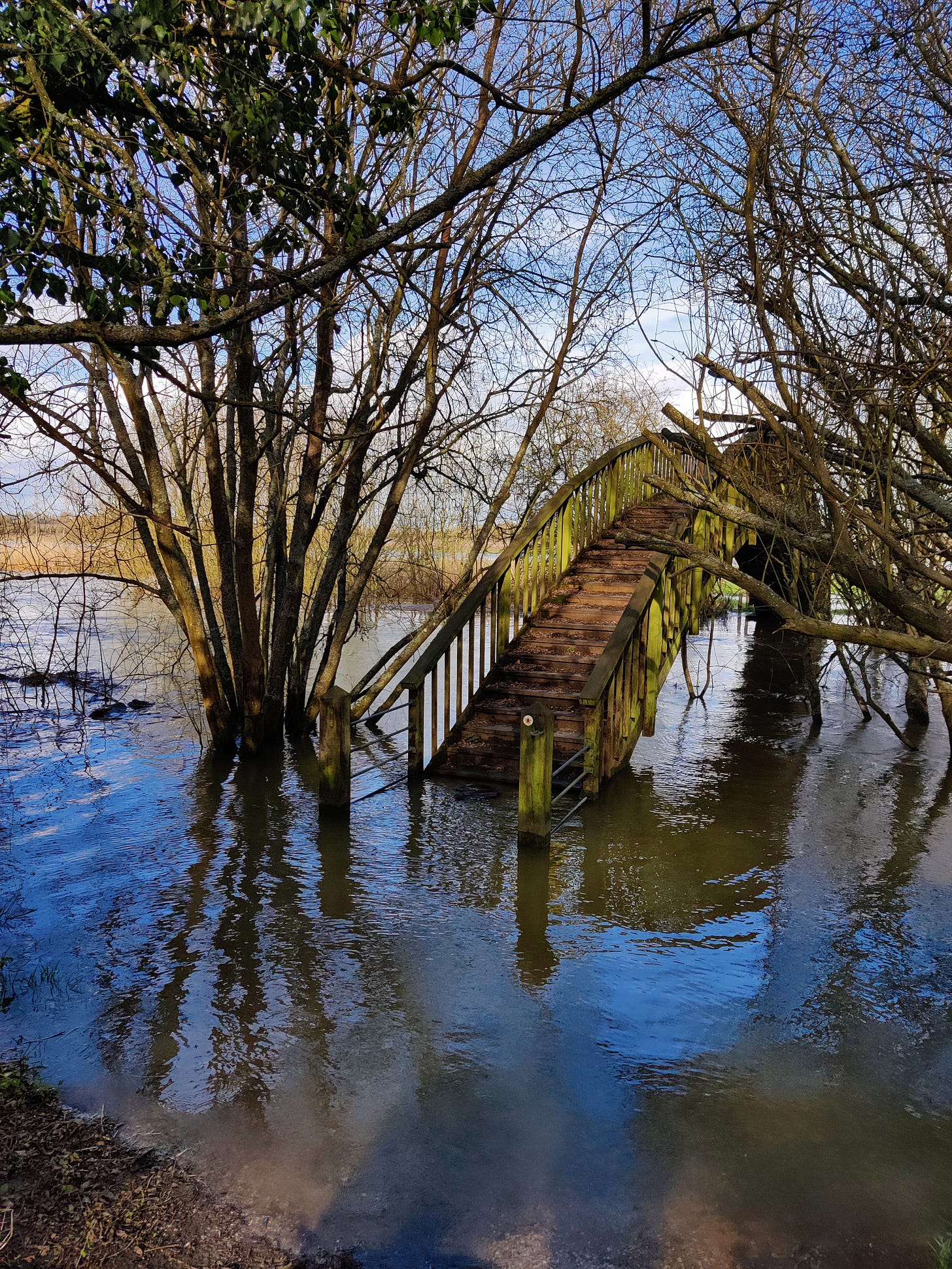
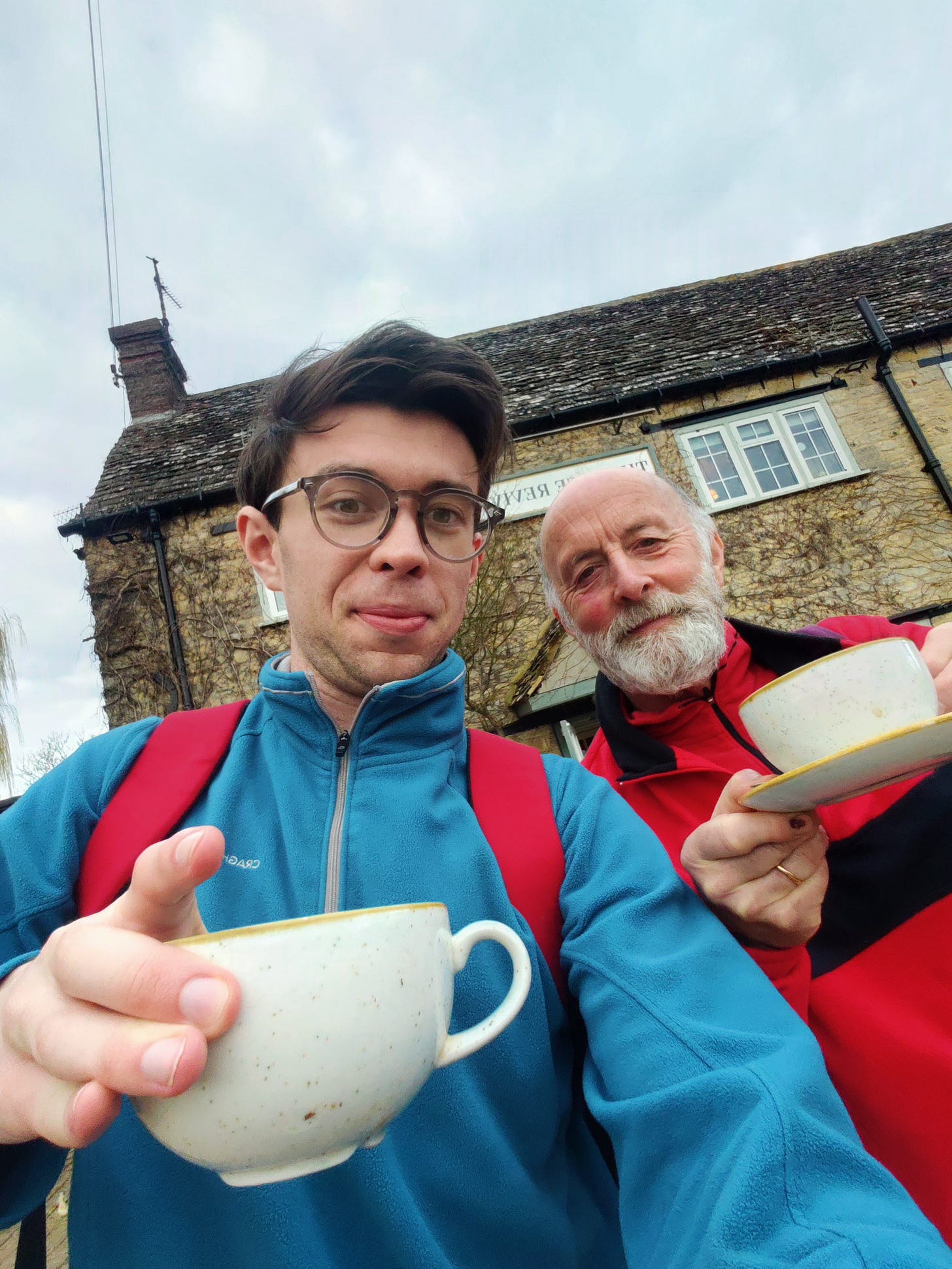
Mad, totally bonkers!
Hope you have both dried out!